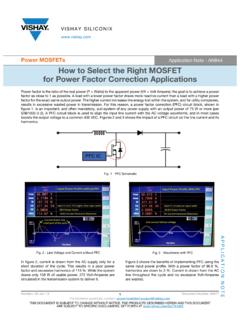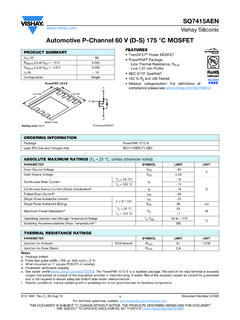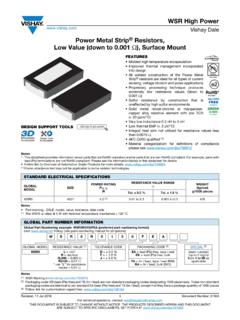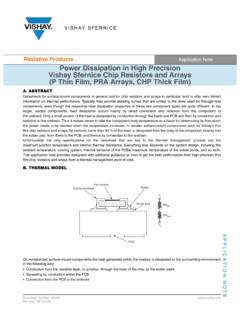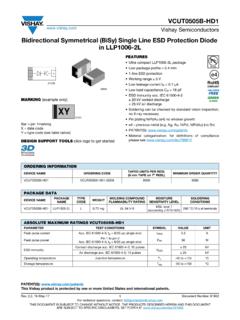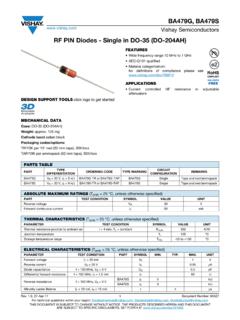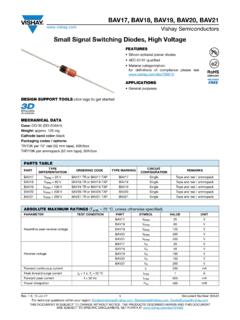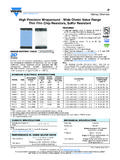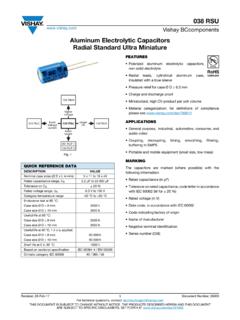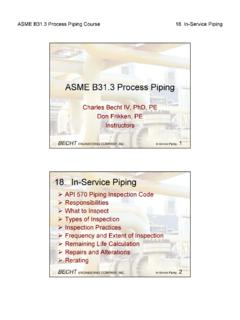Transcription of Measurement Techniques - Vishay
1 Measurement Techniques Vishay Semiconductors Measurement Techniques INTRODUCTION VS = 80 V. The characteristics of optoelectronics devices given in ( > VR max.). datasheets are verified either by 100 % production tests followed by statistic evaluation or by sample tests on typical I = 10 A. 100 A. specimens. These tests can be divided into following constant categories: Dark measurements VR. Light measurements V. Measurements of switching characteristics, cut-off frequency and capacitance Ri > 10 M . Angular distribution measurements 94 8206. Spectral distribution measurements Fig. 2. Thermal measurements Dark and light measurements limits are 100 % For most devices, VR is specified at 10 A reverse current. measurements. All other values are typical. The basic In this case either a high impedance voltmeter has to be circuits used for these measurements are shown in the used, or current consumption of DVM has to be calculated following sections.
2 The circuits may be modified slightly to and added to the specified current. A second Measurement accommodate special Measurement requirements. step will then give correct readings. Most of the test circuits may be simplified by use of a source In case of IR diodes, total radiant output power, e, is measure unit (SMU), which allows either to source voltage usually measured. This is done with a calibrated large-area and measure current or to source current and measure photovoltaic cell fitted in a conical reflector with a bore voltage. which accepts the test item - see figure 3. An alternative test set uses a silicon photodiode attached to an integrating DARK AND LIGHT MEASUREMENTS sphere. A constant DC or pulsating forward current of EMITTER DEVICES specified magnitude is passed through the IR diode.
3 The IR Diodes advantage of pulse-current measurements at room Forward voltage, VF, is measured either on a curve tracer or temperature (25 C) is that results can be reproduced statically using the circuit shown in figure 1. A specified exactly. forward current (from a constant current source) is passed through the device and the voltage developed across it is Photo Voltaic Cell, Calibrated measured on a high-impedance voltmeter. VS = 5 V. I = 50 mA. IF. 100 mA. constant VF. V. 94 8155. R i > 10 k . Reflector 948205. Fig. 3. Fig. 1. If, for reasons of Measurement economy, only DC. To measure reverse voltage, VR, a 10 A or 100 A reverse measurements (figure 4) are to be made, then the energizing current from a constant current source is impressed through time should be kept short (below 1 s) and of uniform the diode (figure 2) and the voltage developed across is duration, to minimize any fall-off in light output due to measured on a voltmeter of high input impedance ( 10 M ).
4 Internal heating. Rev. , 31-Jul-12 1 Document Number: 80085. For technical questions, contact: THIS DOCUMENT IS SUBJECT TO CHANGE WITHOUT NOTICE. THE PRODUCTS DESCRIBED HEREIN AND THIS DOCUMENT. ARE SUBJECT TO SPECIFIC DISCLAIMERS, SET FORTH AT Measurement Techniques Vishay Semiconductors DETECTOR DEVICES. VS = 5 V. Photovoltaic cells, photodiodes Dark measurements I = 100 mA The reverse voltage characteristic, VR, is measured either on constant a curve tracer or statically using the circuit shown in figure Ik 6. A high-impedance voltmeter, which draws only an insignificant fraction of device's reverse current, must be RL used. V. VS > VR. Ri 10 k . IR = 100 A. RL = 1 to 10 94 8207. constant Fig. 4. E=0. To ensure that the relationship between irradiance and VF. photocurrent is linear, the photodiode should operate near V.
5 The short-circuit configuration. This can be achieved by using a low resistance load ( 10 ) of such a value that the Ri 10 M . voltage dropped across is very much lower than the open circuit voltage produced under identical illumination 94 8209. conditions (Rmeas << Ri). The voltage across the load should Fig. 6. be measured with a sensitive DVM. Dark reverse current measurements, Iro, must be carried out A knowledge of radiant intensity, Ie, produced by an IR in complete darkness - reverse currents of silicon emitter enables customers to assess the range of IR light photodiodes are in the range of nanoamperes only, and an barriers. The Measurement procedure for this is more or less illumination of a few lx is quite sufficient to falsify the test the same as the one used for measuring radiant power.
6 The result. If a highly sensitive DVM is to be used, then a current only difference is that in this case the photodiode is used sampling resistor of such a value that voltage dropped without a reflector and is mounted at a specified distance across it is small in comparison with supply voltage must be from, and on the optical axis of, the IR diode (figure 5). This connected in series with the test item (figure 7). Under these way, only the radiant power of a narrow axial beam is conditions, any reverse voltage variations of the test considered. samples can be ignored. Shunt resistance (dark resistance). The radiant power within a solid angle of = steradian is determined by applying a very slight voltage to the (sr) is measured at a distance of 100 mm. Radiant intensity photodiode and then measuring dark current.
7 In case of is then obtained by using this measured value for calculating 10 mV or less, forward and reverse polarity will result in the radiant intensity for a solid angle of = 1 sr. similar readings. VS = 20 V. Photo Voltaic Cell with Filter E=0. (Calibrated), 1 cm 2. = sr Iro 10 k mV. Ri 1 M . a = 100 mm 94 8210. Position of the Emitting Area Fig. 7. 94 8156. Light measurements Fig. 5. The same circuit as used in dark Measurement can be used to carry out light reverse current, Ira, measurements on photodiodes. The only difference is the diode is now irradiated and a current sampling resistor of lower value must be used (figure 8), because of the higher currents involved. Rev. , 31-Jul-12 2 Document Number: 80085. For technical questions, contact: THIS DOCUMENT IS SUBJECT TO CHANGE WITHOUT NOTICE.
8 THE PRODUCTS DESCRIBED HEREIN AND THIS DOCUMENT. ARE SUBJECT TO SPECIFIC DISCLAIMERS, SET FORTH AT Measurement Techniques Vishay Semiconductors VS = 20 V. the same lux and color temperature calibration) may result EA = 1 klx or in readings that differ up to 20 %. Ee = 1 mW/cm2 The simplest way to overcome this problem is to calibrate (measure the light current) some items of a photodetector type with a standard lamp (OSRAM WI 41/G) and then use these devices for adjustment of the lamp used for field Ira measurements. An IR diode is used as a radiation source (instead of a Tungsten incandescent lamp), to measure detector devices 10 mV being used mainly in IR transmission systems together with Ri = 10 k . IR emitters ( , IR remote control, IR headphone). Operation is possible both with DC or pulsed current.
9 The adjustment of irradiance, Ee, is similar to the above 94 8211. mentioned adjustment of illuminance, Ev. To achieve a high Fig. 8 stability similar to filament lamps, consideration should be given to the following two points: The open circuit voltage, VO, and short circuit current, Ik, of The IR emitter should be connected to a good heat sink to photovoltaic cells and photodiodes are measured by means provide sufficient temperature stability. of the test circuit shown in figure 9. The value of the load resistor used for the Ik Measurement should be chosen so DC or pulse-current levels as well as pulse duration have that the voltage dropped across it is low in comparison with great influence on self-heating of IR diodes and should be the open circuit voltage produced under conditions of chosen carefully.
10 Identical irradiation. The radiant intensity, Ie, of the device is permanently controlled by a calibrated detector. Phototransistors 1 to 10 . The collector emitter voltage, VCEO, is measured either on a transistor curve tracer or statically using the circuit shown in EA = 1 klx or figure 10. Normal bench illumination does not change the Ee = 1 mW/cm2 Ik VO measured result. mV. Ri 10 M . VS = 80 V. 94 8212 ( < VCEO ). Fig. 9. IC = 1 mA. constant The light source used for the light measurements is a calibrated incandescent tungsten lamp with no filters. The filament current is adjusted for a color temperature of 2856 K (standard illuminant A to DIN 5033 sheet 7). A E < 100 lx VCEO. specified illumination, Ev, (usually 100 lx or 1000 lx) is produced by adjusting the distance, a, between the lamp V.
